Monday February 20, 2017
For: No dramatic changes, improved cockpit, makes a dull drive feel special
Against: Silly hill holder light, demands sat nav or at least CarPlay
By Richard Bosselman
MESSING with loved original recipes can be hugely risky; just ask Coke and KFC.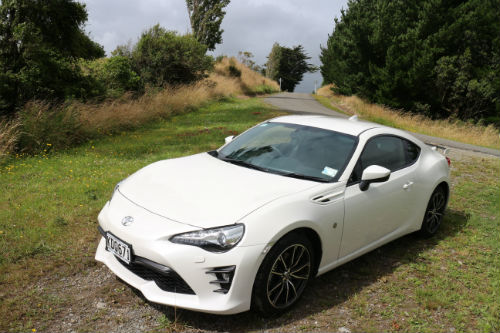
Even so, five years into the life of the fabulous 86, Toyota had no choice but to effect change to their landmark coupe because, in the car world, time and technology doesn’t stand still. Even the best-sorted products demand ongoing evolution. Our automotive tastes are so much more complex than for carbonated drinks and fried chicken.
So, regardless that great cars aren’t easily created – and that making great cars even better can be all the more of a challenge, still – they’ve taken the plunge and meted this brilliant rear-drive coupe a refresh.
Inevitably, 86-ists are going to fret about the potential for over-flavouring; so easily done when the original recipe seems such a perfect blend.
The first point to make is that, in a purely dynamic – and thus driving enjoyment - sense, the manual GT coupe on test here seemed every bit as good as it has ever been. The balance, the feedback, the intuitive-ness … it’s still all there.
Which means that it remains better than anything else it competes with? I suppose that conclusion could be drawn, though it’s an empty argument, simply because no other brand presently dares to create anything quite like this lightweight two-plus two sports car.
So it’s special. And, in all probability, it will continue to sell in such small count that some will wonder why this maker bothers to keep it in stock.
But that’s simply the way it is sometimes; you need look no further than Toyota-dom to find example of why it’s so dangerous to assume that sales success should have anything to do with status. Corolla is a huge seller, but it’s not a patch on the 86 in any way. Not just in physical feel, but also in respect to the psychological: The coupe just oozes with a ‘feel good’ that doesn’t impart from regular Toyotas.
That a mere 600 86s have been sold in New Zealand since the initial launch back in 2012, that more 70 percent of those were in the first two years of its time here and that, in the interim period, the car’s single-biggest client has been the motorsport series that primarily keeps its presence in the public eye .. well, that’s of no particular consequence.
Fact is, the 86 was never meant to be a volume seller; its purpose was to make Toyota cool again after years of worthy but boring kitchen-appliance motoring. Well, mission accomplished there.
But now it’s the usual story: Simplicity and purity were the keystones of this car. Have the Model Year ’17 modifications to the 86 made it too good?
Design
While the primary focus of this revision has been to further sweeten the responsiveness, balance and handling, the stylists have not been left idle.
All the same, they’ve not had to sweat: With every panel having been left unsullied, it’s all minor redecoration for the $51,986 manual GT on test.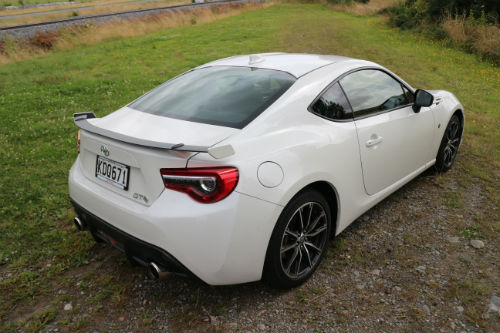
A bumper change up front has been enough to provide a revised face – it’s got more of a smile now. There are new wheels, slightly revised headlights, new taillights and a new diffuser atop the boot. Oh yes, for some reasons, they’ve altered the badge locations.
It looks different. But does it look better? Put it this way, if I owned an original car, I wouldn’t be upset. And if I bought into the new one … well, same thing. The new detailing is nice, perhaps a little too enforced in places – those new strakes, for instance, seem to be there simply as a ‘because we could’ enhancement - but hardly life-changing. Toyota is definitely playing safe. It’s patently freshened, but not to any particular extreme. Overall, it just gives something for the fanbase to chat about, but in friendly fashion. There’s nothing here that could or should cause fisticuffs. I daresay the most obvious addition, that new boot spoiler, could retro-fit to older cars.
The interior achieves extra attention. The original layout was quite fundamental and unfanciful because Toyota perceived that owners, either on cost grounds or because they were going to change it anyway for motorsport intent, didn’t want anything too expensive-looking. Unfortunately, a logic that paid off for a legion of rally-bound Evos and STi Imprezas didn’t really apply to the 86; which – race series-dedicated examples aside – has generally become a road car which has been used for occasional track excursions.
The new cockpit fulfils that function better. There’s still not a lot of flamboyance to the overall design, but the ingredients have improved, with not only a more coherent speedo and tachometer – now front and centre, as it should be - but some additional digital displays that I’d find quite useful on a club racing day, particularly the lap timer.
Toyota has also done a better job of either replacing, or at least disguising, the cheap plastics, even slapping in a bit of Alacantra here and there. Though not where it would be appreciated most: On the rim of the steering wheel which, incidentally, remains the smallest ever fitted to a Toyota, though it’s even smaller now – from 365mm down to 362mm – and better shaped, with a thicker rim.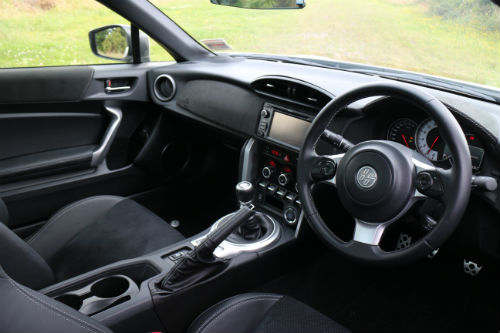
The wheel also now has controls; on the left, audio controls and on the right, display units. I’m not sure that does anything to enhance the car’s sense of purity, but they are useful. Particularly those that operate the audio, because the head unit that Toyota uses is designed to infuriate in every possible way.
The issues? Here are a couple. The screen is so affected by glare in any kind of sunlight that it becomes impossible to read. Also, a large touch screen is pointless when the touch buttons are so tiny. You’re talking fingernail rather than fingertip contact. Toyota still doesn’t implement sat nav, which makes it’s resistance to Apple CarPlay/Android Auto all the more annoying, however it does now includes a reversing camera, which is good in a car with so many rearward blind spots, but would be even better were there guidelines on the screen. And, course, radar isn’t part of the package, either.
New seats affect more of the look of competition racing chairs, though how good they’d be in that role is a moot question: One neat trick with the original seat was that you needed simply to turn the headrest around to make it perfect for helmeted driving. But no question that they’re comfortable and supportive in road use.
And the driving position remains a study in perfection. Ergonomically, the reach and height-adjustable wheel couldn’t be better positioned and all the controls are easy to reach. You sit low and can see the twin rises of the wheelarches left and right so there’s very much a sense of being in a performance car. It’s snug, so much so that the maker continues to economise on some opportunities. Like thinking about making space to slot a cellphone or even spare coins. On the other hands, they still pretend that the rear seats are useful, when patently they are not. Better to fold them down to improve on the boot space.
Powertrain
A flat four engine not only reflects the 86’s Subaru heritage but also gives it commonality with a certain German elite sports car brand, though that Porsche pretension does seem a stretch when you realise the 86 engine still lacks a turbocharger. And probably always will.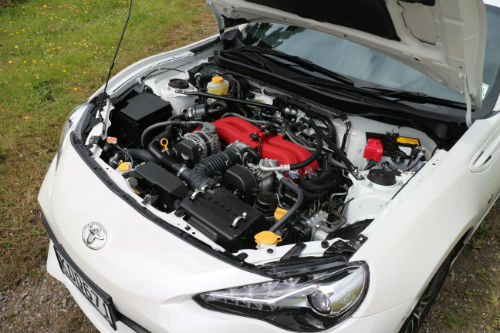
The manual model on test has the more powerful version of this engine, and though actual outputs of 152kW and 212Nm – when feed on 98 octane fuel - are not giant-threatening, they’re slightly up on the original. Also, this engine feels smoother and more zesty in the mid-range.
Overall, though, it’s a powerplant that needs – actually, demands - to sing for its supper, but it does so with a fervour that’s simply intoxicating. There are precious few non-supercar league engines that beg to be booted like this unit does. And it combines beautifully with that short-throw six-speed gearbox. Basically, same as before, then.
At least, now, when you lift the bonnet the engine looks a lot more interesting, with Toyota having splashed out for a rocker cover rhat’s not ony now painted but crinkle-finished, just like Alfa Romeo does it.
Experience
Everything is perfect …
Actually, not quite true, though it says heaps about how well-sorted this car is in its fundamental role that the only, and abiding, annoyance of the entire test period was caused by a dashboard light.
Hill holders are useful and since this is a Subaru at heart, it was only a matter of time before the 86 got one. I don’t mind it. Neither did I mind seeing the illuminated ‘car on slope’ icon symbol slap in the middle of the dash when I fired up the car for the first time, thinking it would blink off once the car was going. Only it didn’t. In fact, it never did.
In theory, the hill-holder light can be deactivated. In reality, it’s a damned difficult task, because there’s no on/off button. Instead, you have to go through a daft process that involves button stabbing for a time duration and sequence that defies logic and patience.
So, that’s my beef.
Otherwise? Brilliant. From the moment you hit your first decent corner, it reaffirms as the most fun and loveable budget sports coupes ever.
And I’m conceding that as an owner of a first-generation Mazda MX-5 (which is, in my view, the most fun open-topped budget sports car ever). Yet I’d concede the 86 exhibits better turn-in and more measured steering response than the Mazda in all but its latest evolution, and even then it’s a tight contest.
In handling terms, too, it is a delight. Tenacious front-end grip and a flat, neutral stance make it a delight to push ever harder through bends, and if and when oversteer comes the stability control does whatever is necessary to keep the car true.
Out on the road power oversteer can be induced, though not as easily, and again the electronic safety aid will step in, unless you’ve determined to deactivate it. In which case, the car can feel more on the edge, but rarely wildly over it. But really, though the traction controlling electronics sometimes feel intrusive, it’s best not to fully loosen that rein until the car is out on the track.
Ride comfort is not bad, given the nature of the car. Revisions to the spring and damper rates is not to the point where it loses firmness, but the ride seems less punishing and quieter. It also seems less troubled by ruts and ripples, though only to a point. This is a low-slung sports car, not a limo, after all.
Braking is strong and the pedal is quite firm, but provides respectable feedback when you’re standing hard on the pedal.
There’s nothing better than a manual 86, regardless that it is not an effortless drive. Around town it can be a pain juggling the clutch and throttle when driving, because this is something of an all-or-nothing car.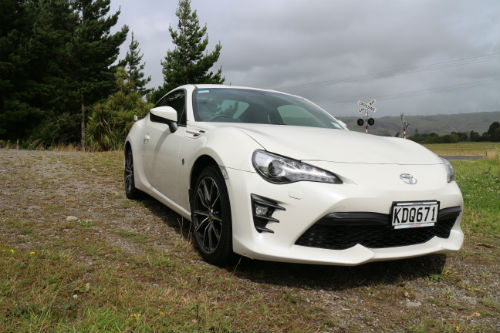
The drivetrain has to be worked hard to be fully enjoyable, because the power band is not broad and there’s precious little torque down low; moreover the muscle reaches its peak at 3000rpm and then dips before steadily climbing again from 4000rpm.
Even though engine noise has been quietened now, it’s still a busy car. At 100kmh in sixth the tacho needle is sitting at roughly 2700rpm and for maximum enjoyment it's best to have the engine hitting at least 6000rpm before shifting up. Presumably that's the transitional point where the car's port fuel injection hands over to the direct injection system. Whatever, it’s a sweet spot that needs to be reached. Again and again and again. Revs are good. Rejoice.
While the manual transmission's shift is light and precise, another challenge comes from the clutch requiring precision to achieve a tidy bite, take-up being in a narrow band near the top of the pedal's arc.
But the reward is linear acceleration across the rev range, right up to the redline and a sense of close involvement that surpasses mere enjoyment. It’s exhilarating. They’ve even managed the seemingly impossible and finally even started to make the engine sound properly rorty.
Verdict
Improving the 86 was always going to be challenging, but in many respects they’ve done it. The cabin is tidier and better provisioned; the engine sounds and feels a touchy more interesting and the handling is as the handling has always been: Superb. Some of the exterior alterations seem to have been undertaken for no good reason other than to ensure the ’17 won’t be mistaken for an earlier edition. But it’s still a good-looking car.
All it really needs is an ‘off’ switch for that hill holder light. Otherwise, it’s as as sweet as ever and worth the $4500 increase over its predecessor.
Overall, this car is in great shape to keep the legend alive until 2019, when a successor car comes along. In some ways I can’t wait. In some ways, it seems a shame knowing that the car we have now is already on borrowed time.


